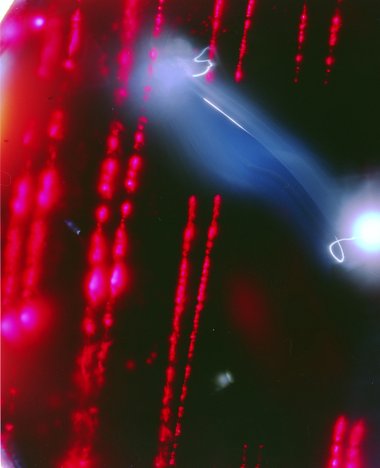John Hurrell – 19 September, 2011
It is hard to believe they are photographs not remotely representational (even of abstract painting), instead the results of a explorative light manipulating process; that they are only indexical to the physical interaction of the camera with the rocky ground, turbulent air or other meteorological conditions - not some aimed at and captured subject matter.
More photographic image-making wizardry here from Darren Glass, using his collection of highly functional handmade sculptures that double as pinhole cameras - sometimes multi-apertured - presenting his characteristically frenetic traces of spun around and jostled light.
I see the photographs as far more interesting than the sculpture which although fascinating as handmade objects, are only important as a means to an end. They are ‘the shadow’, the image print on paper is ‘the substance.’
Most of the images in this current show are coincidentally akin visually to improvised, gestural but soft-edged, painted abstractions, like smeared, scratched or sprayed, garish (or bleaching) squirts from some lurching convulsive tagger. Others are densely holistic in the manner of early Mark Tobey, with delicate grey, fine-lined, grassy fields that seem rhythmically drawn, caressed, seeded and sprouting. It is hard to believe they are photographs not remotely representational (even of abstract painting), instead the results of a explorative light manipulating process; that they are only indexical to the physical interaction of the camera with the rocky ground, turbulent air or other meteorological conditions - not some aimed at and captured subject matter.
Of the nine photographs, four come from airborne Frisbee cameras (Cosmo Flying Discs). One type has one pinhole, the other seven. With the first variety Glass has deliberately not attached the film firmly to the floor of the Frisbee, letting it slide around in mid-flight so that intermittent lines and blurry streaks appear.
With some other shots Glass has aimed his vertically distorting box-camera at Mt Taranaki but used a very long tube as a telephoto viewfinder to gain an extremely long focal length, so long a tripod is needed to support it at each end. With another large lozenge-shaped box camera featuring two carefully separated pinholes. he has exposed the film while walking along a track on the side of Mt Tongariro. The resulting landscape consists of upright and inverted vistas alternating in parallel rows along the length of the print.
Two other images were made by a robust camera in the form of a hollow plywood ring (it has 105 pinholes) designed to be rolled down the side of rocky volcanic craters. The resulting intricate images are found on a long strip densely packed with wavy hairy lines as if taken from an animal’s pelt. It becomes deceptively as a visual statement a peculiar sort of machine-made drawing that somebody like Rebecca Horn or Jean Tinguely might have invented. Or of course Simon Ingram.
It is always a buzz to see what Glass comes up with in his displays of unusual photographic images. Because I have a personal predilection towards nonobjective imagery (although that term I am inclined to argue about), I tend to be intrigued by Glass’s ‘painterly abstractions’ more than his narrative themes such as landscape walks or fishing - though they are hard to ignore. The Good Oil.
John Hurrell






 Advertising in this column
Advertising in this column Two Rooms presents a program of residencies and projects
Two Rooms presents a program of residencies and projects



This Discussion has 0 comments.
Comment
Participate
Register to Participate.
Sign in
Sign in to an existing account.